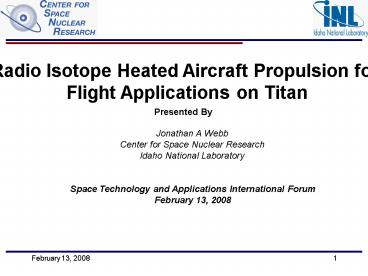Meeting Agenda February XX, 2004 - PowerPoint PPT Presentation
1 / 19
Title:
Meeting Agenda February XX, 2004
Description:
Space Technology and Applications International Forum ... GNC. 19.5. Thermal. 26. Structures. 22.4. Telecom. 0. Shielding. 20.63. Thermal Power. 6.016 ... – PowerPoint PPT presentation
Number of Views:54
Avg rating:3.0/5.0
Title: Meeting Agenda February XX, 2004
1
Radio Isotope Heated Aircraft Propulsion for
Flight Applications on Titan
Presented By
Jonathan A Webb Center for Space Nuclear
Research Idaho National Laboratory
Space Technology and Applications International
Forum February 13, 2008
2
Agenda
- Why Titan
- Titan Exploration Challenges
- Proposed Aircraft
- Aircraft Propulsion Methods
- Conclusions
3
Why Titan??
- High density atmosphere (98 N2, 2 CH4)
- Rivers and lakes of Methane
- Cryo-volcanism
- Immense amounts of organic materials
- EARTH-LIKE EVOLUTIONARY PROCESS
4
Why Titan ??
- Titans orbit dips deep inside Saturns
magnetosphere - Charged particle interactions create complex
organic molecules - Molecules precipitate and interact with other
chemicals
5
Proposed Architecture
- Drifts at 32,000 ft altitude
- Drifts at 10 knots
- 278 kg flight mass
- Little ability to steer
- Can not loiter in one area
6
Fixed Wing Alternative
- Fly a fixed wing craft
- Ramjet
- Turbojet
- Turboprop
- Turbofan
- No Oxygen for Combustion
- Replace combustion chamber with radioisotopes
- Ultra-long flight durations
Proposed Mars aircraft
7
Isotopes
- 238Pu
- - a emitter
- - 87 yr half life
- - limited inventory
- - 413 W/kg as PuO2
- 90Sr
- - ß- emitter
- - 29 yr half life
- - available at Hanaford
- - 396 W/kg in an SrO form
- - 239Pu fission products yields a higher ratio
of 90Sr to 88Sr - - 239Pu fission products yield SrO at 546 W/kg
8
Ramjet Engine
- No moving parts
- Simplicity
- Most power intensive at low velocity
- Least power intensive at supersonic velocities
9
Turbojet Engine
- Least power intensive at high subsonic
velocities - Requires moving parts
- Thrust producing device
10
Turboprop Engine
- Power producing device
- Similar to a turboprop
11
Ramjet
12
Turbine Propulsion
13
Turbine Propulsion
14
Turbine Propulsion
15
2 inch Turboprop Fuel Mass
16
Mass Budget
SrO 69/31
SrO 50/50
PuO2
17
Conclusions
- Required temperatures, power and compression
ratios are within current levels of experience - A turboprop flying at 64,000 ft seems to be the
optimum flight configuration - More work is required in turbo-machinery design,
shielding design and heat transfer - Radioisotope powered long duration aircraft
appears feasible for deep space exploration
missions
18
Acknowledgements
- Center for Space Nuclear Research
- Steven Howe
- CSNR Summer Fellows
- M. Dhanasar, B. Gross, J Katalenich, M. Keller,
C. Miller, D. Osterberg, J. Perkins, P. Ramu, T.
Reiss, J. Sasser, B. Schrieb, H. Szumilla, R.
Obrien, J. Joyce, L. Sailer, C. Robinson
19
Questions ??































